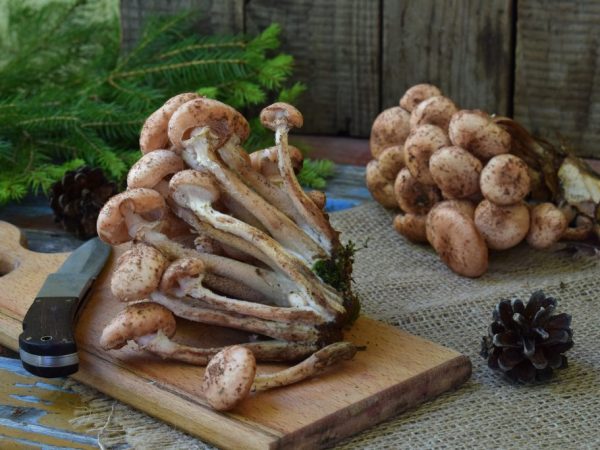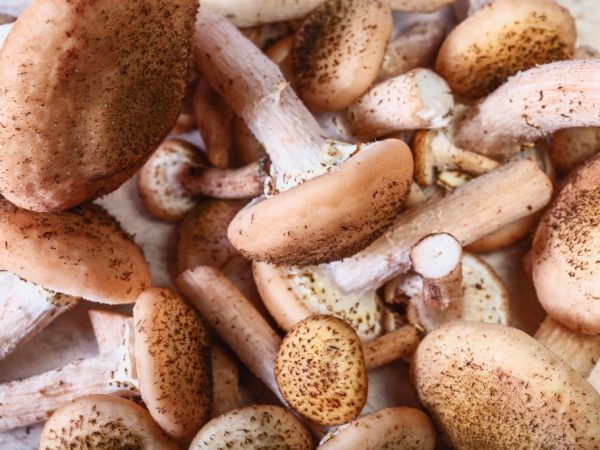Rules for processing fresh mushrooms
One of the popular varieties of mushrooms is honey agarics - they retain their peculiar taste when fried, pickled and salted. Correct pretreatment of honey agaric is an important step, which is mandatory before cooking, because pieces of earth, blades of grass and leaves accumulate on the mushrooms.

Rules for processing fresh mushrooms
Primary processing in the forest
To facilitate the subsequent stages of cleaning, it is worth starting the process right at the time of collection. This is time-consuming, but less work at home. Wormy and damaged specimens should be weeded out of the basket immediately. From the bottom of the leg, remove dirt, earth, needles and adhered twigs with a sharp knife, cut off the bottom. Be sure to cut off the part that is damaged by worms. It is not necessary to remove the wavy collar (which we also call the skirt) on the leg - this does not affect the taste of the prepared dish.
From the lower half of the leg, the part that attached the mushroom to the mycelium is carefully cut off. The film is removed from the cap. If the mushroom is cut, not plucked, then there is no need to remove dirt and residual mycelium from the base of the mushrooms. The most delicious part is the caps, so you can get rid of the stem and not handle the dirtiest part of the mushroom.
Home cleaning technique
Immediately after walking through the forest, the harvested crop is sorted. Fresh mushrooms, cut off from the mycelium, begin to darken quickly. Processing should not be postponed more than 3 hours after collection, because mushrooms spoil very quickly. Do not leave them in the package. Correctly clean mushrooms immediately upon arrival from the forest. If for some reason timely cleaning is impossible, the crop is dipped into cool water with the addition of a spoonful of citric acid and the same amount of table salt.
To properly clean mushrooms, you need a sharp knife, a colander and a sponge. The latter is needed to wipe the legs and caps. Dirt is cleaned off the lower part with a knife, in some cases the entire bottom is cut off. Before cleaning, the legs are separated from the caps.
All damaged areas are removed. The rim under the hat can be removed or washed off with a stream of water. After that, all the mushrooms are thoroughly washed (if you are not going to dry them). Young mushrooms do not need to be cleaned.
The steps to follow will vary depending on the preparation method. Cleaning will require a sharpened compact knife, a stiff-bristled toothbrush, and a piece of soft cloth.
Irina Selyutina (Biologist):
If you have harvested a large crop, then it is better to divide it into several parts for processing. Those mushrooms that you want to leave can be placed in a cool room, where there is no access to direct sunlight and laid out in one layer on the newspaper. In this state, they can lie for a day, during which time they will partially dry out and they can be cleaned dry. However, it is still best to deal with the mushrooms immediately upon returning from the forest. This will preserve the crop and help avoid further poisoning.
- Honey mushrooms for drying: in this case, contact of the mushrooms with water is excluded - the absorbed moisture will not completely evaporate from them, therefore, high-quality drying will not take place and, as a result, your workpiece will not be stored for a long time. With the help of a brush, the plates under the hat are carefully combed - there may be bugs sitting there. A soft cloth is used to wipe off the remaining sand.
- For pickling: preliminary soaking in liquid for 40 minutes will be required (only you cannot keep it for more than 1 hour - then honey mushrooms will lose some of their taste). Instances for this method of processing are selected healthy and large. The "skirt" is removed. Then the products are washed under a cold stream for no more than 3-5 minutes. Newly grown mushrooms need half an hour soaking in water with salt before washing. The next stage is cooking in salted water for about 40 minutes. After all the procedures, it is allowed to start processing.
- For freezing: this method of processing requires only freshly harvested specimens. Mushrooms for freezing are selected carefully, damage, even minor, is unacceptable. With a stiff brush, the mushroom is cleaned of dust particles, branches, etc. Little mushrooms do not need to be cut into small pieces. The mushrooms are not washed in water.
Irina Selyutina (Biologist):
If mushrooms are heavily soiled, you will have to wipe each hat with a cloth dampened with water or an old kitchen towel and leave to dry for 1 hour. Only after that mushrooms are laid out containers or packages in portions and sent to the freezer. If you want some of the mushrooms to be frozen separately, then spread the mushrooms on flat surfaces of trays or cutting boards, freeze and only then place them in bags or containers for storage in the freezer.
If you have collected overgrown mushrooms, then immediately determine their quality. If it suits you (appearance, smell) - leave the mushrooms for further processing. Mushroom caviar or pate is the best option for overgrown cooking.
Honey agarics washing technique

Washed mushrooms must be cooked immediately
Immediately after the mushroom picker has finished processing the fruit bodies, he washes them under cool running water using a colander. To flush the mushrooms and get rid of the "skirt", the pressure is increased.
The washed fresh mushrooms should not be left overnight. If after harvesting there is no time to immediately start cooking, the crop is poured with boiled water for 20 minutes, laid out along the colander, poured over with cool water and put in the refrigerator. Such a thermal procedure ensures the safety of honey agarics and guarantees their long-term storage.
Soaking honey agarics
Soaking is done after pre-treatment in the forest and before cutting the bottom of the legs and rinsing under water. The purpose of soaking is to get rid of the worms completely. It will take 1 tsp. salt per 1 liter of water (as a preventive measure - half a spoon). The salt should be completely dissolved in the liquid. After the mushrooms are covered with the solution, the worms will float to the surface. The soaking time and the form of processing depend on the size of the mushrooms:
- salting: soaking in a steep saline solution for 2 hours;
- cooking: the procedure is optional, the main focus is on cleaning and washing the mushrooms;
- pickling: the crop is soaked for 30 minutes or poured over with boiling water, immediately after which it must be processed;
- frying: no soaking required;
- drying: contact with water is contraindicated.
Conclusion
Processing honey agarics after harvesting consists of several stages, the technique of which depends on the method of preparation. Following the instructions, the mushroom picker is able to clear the crop from litter without damage. High-quality processing will allow you to prepare a delicious treat from the collected honey agarics.



